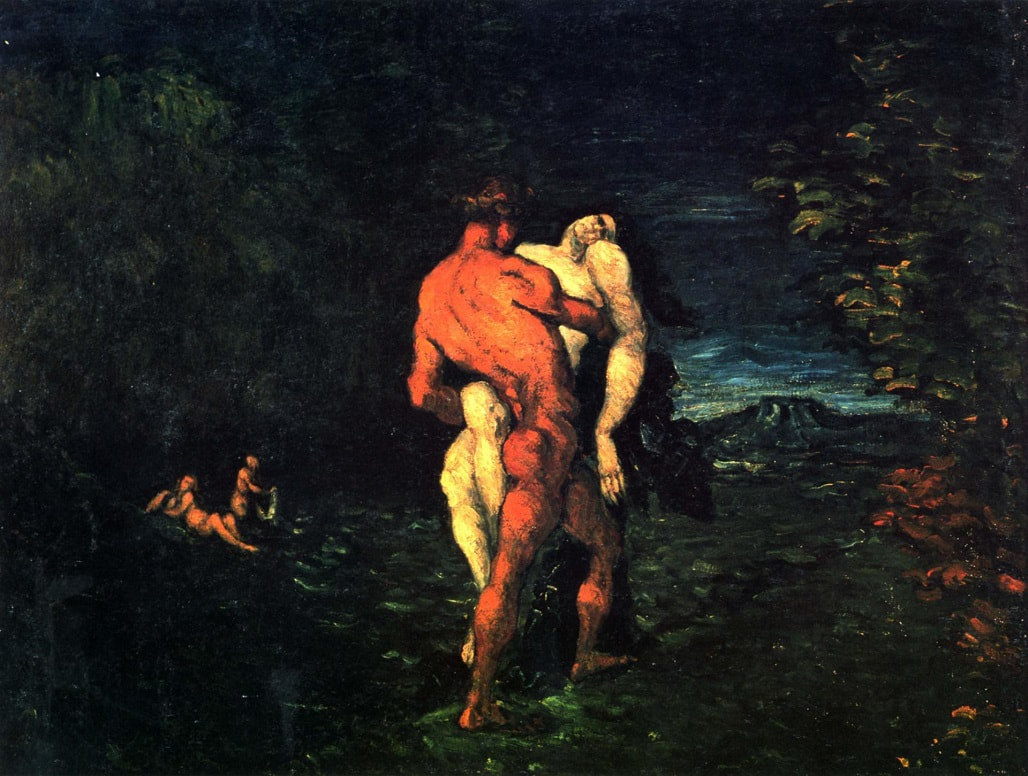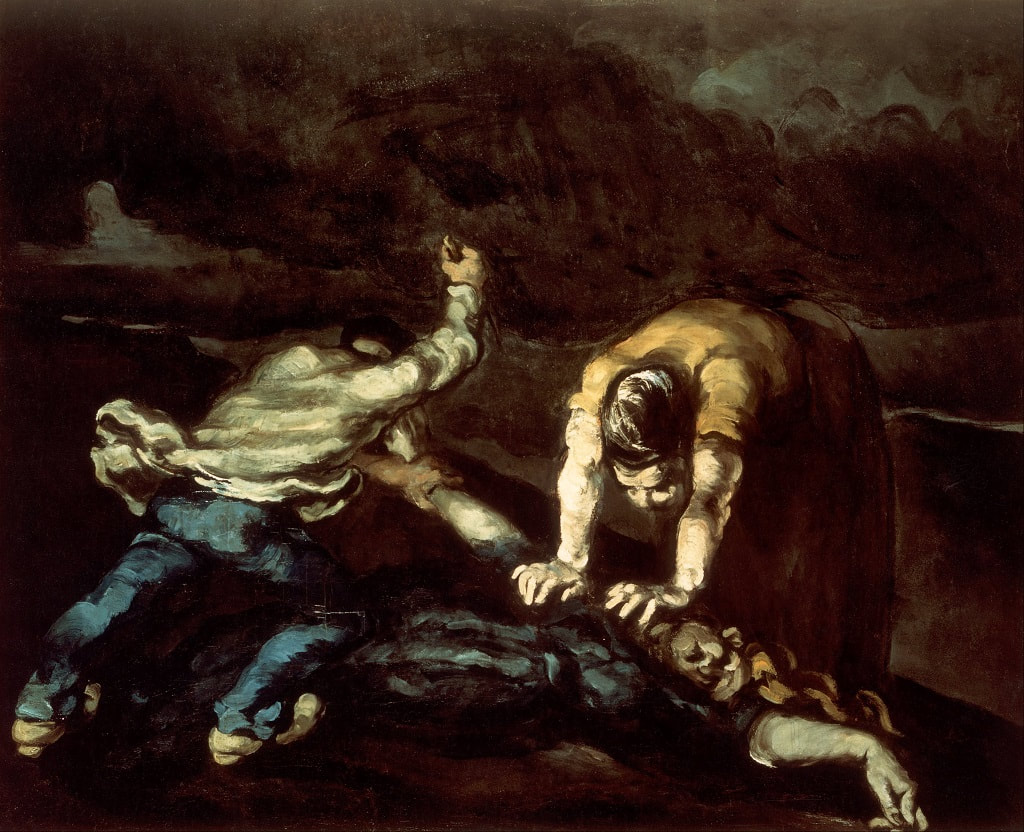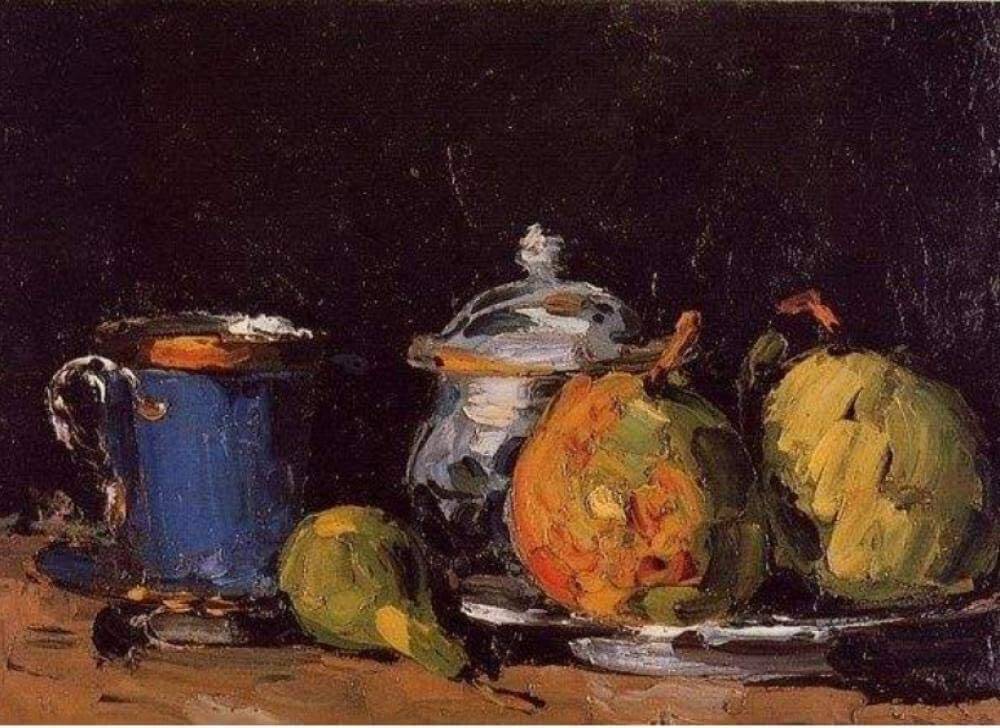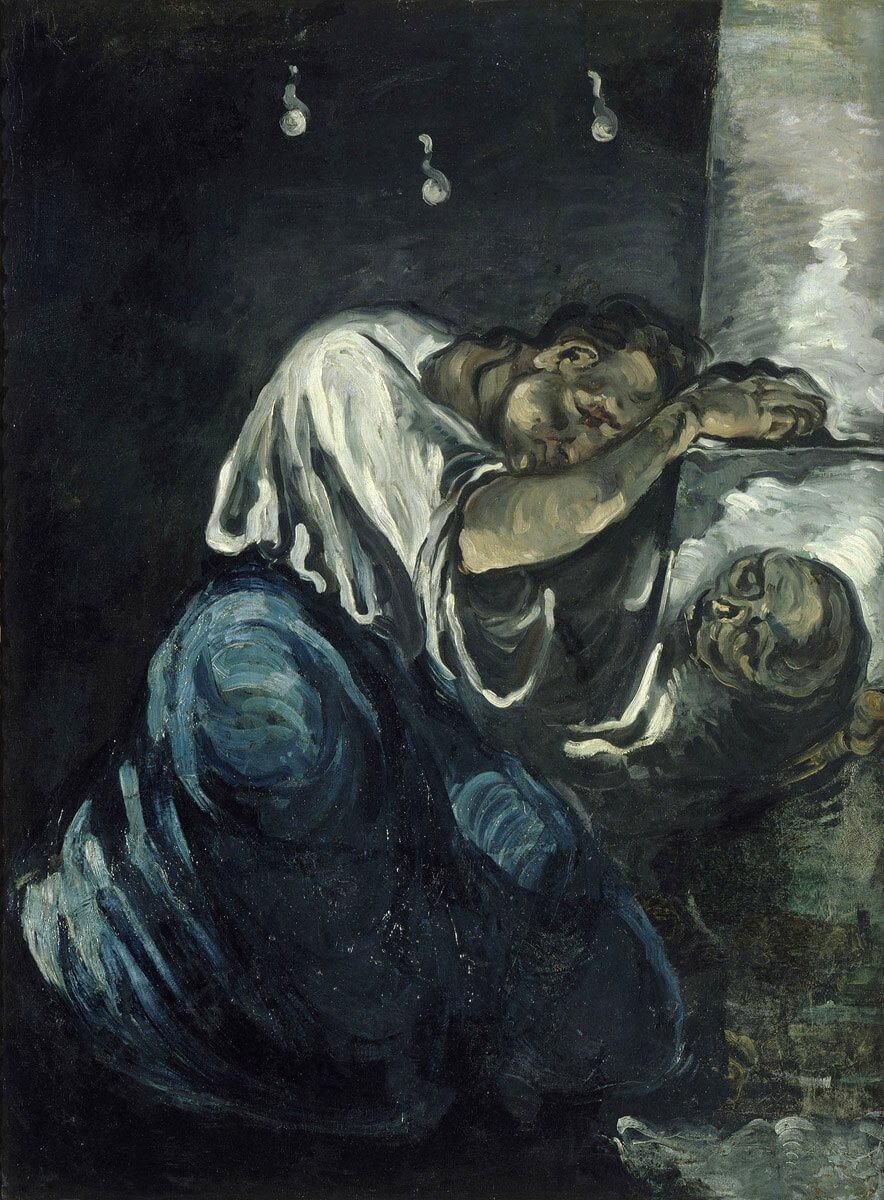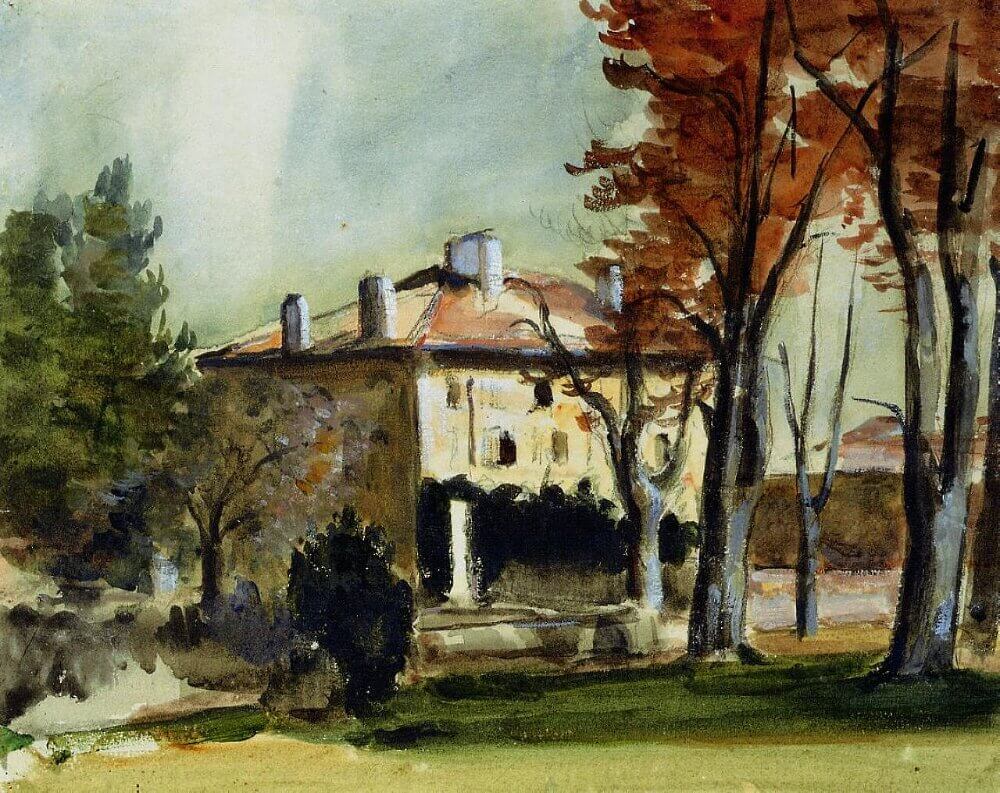|
Four Stages in Cézanne's Career: This post is part of a series of four providing an overview of the development and change in Paul Cézanne’s approach to his landscapes from the 1860s to the early 1900s. Each part is concerned with a time period of approximately 10–12 years. Scholars have recognized each section and have named them for convenience of recognition.
Where? Städel Museum in Frankfurt
When? 1870–1871 Medium and size: Oil on canvas, 65.0 cm by 53.7 cm. What do you see? This is one of Cézanne’s early landscapes from his late “couillarde” period. He crudely described his own style at the time as ‘ballsy.’ Between 1862 and 1872, he painted in very dark colors, the paint applied thickly with a palette knife or thick impasto brush strokes. The strokes are visible and create texture that has a visceral feel to it. By zooming in on the painting, the navy-blue to almost black background is visible. It helps to create the sinister, unseen, section of the road. Light sources come from the yellow brush strokes slashed on the tips of the tree branches and white paint was applied on the road and rocks on top of the undercoating of darker navy/gray. The layering and alternating light/dark colors produce the perception of depth. Waves of brush strokes create the rocks on the right. The strokes appear to have been painted quickly, dragging and dropping bits of color as the brush flew across the canvas, almost in rage or frenzy. The brush strokes and the composition of the trees and rocks draw the eye upwards to the darkness. It is a powerful piece of art that pulls the viewer in, an invitation to experience either the lightness of the sunrise/sunset or to feel the impending darkness and with it a sense of foreboding. The rocks and trees loom over the road, a dare to walk or ride along it. The story choice is the viewer’s but with Cézanne’s paintings, there is always a demand for a reaction.
Back Story: Cézanne lived between Aix-en-Provence and Paris from the time he was 21 (in 1860) to age 32. He and Émile Zola met at school and grew up together in Aix, where they spent their free time wandering the river banks and woods discussing literature, poetry, politics and art, dreaming of the days when Zola would be an influential literary figure and Cézanne a great artist. After finishing school, Zola was insistent that Cézanne should join him in Paris. To please his father, Cézanne first made an unsuccessful attempt to become a lawyer. He then tried to work in his father’s bank, but he was so unhappy that his mother and sister helped to convince his father that he should go to Paris and study art there. His father agreed but would only provide a limited allowance.
Cézanne was rarely comfortable in either place as he searched for himself and who he was as a painter. At home in Aix, he longed for his father’s approval and greater financial support for his choice of career. In Paris, unlike Émile, he could not adapt to the sophistication of city life. Rather than becoming a young sophisticate in an artistic atmosphere, he chose to present himself as a rather uneducated, gruff, Provençal (peasant or country person) and found he and his style of art were rejected, misunderstood, and ridiculed by both critics and the public. Any support that he had, came from his fellow artists. S. Roe, an art historian described him in her book, The Private Lives of the Impressionists as: “Tall, round shouldered, with short, black hair, swarthy dark skin and a black, drooping mustache, he aroused great curiosity...at twenty-two, Cézanne was intense, clumsy and paranoid; he seemed suspicious of everyone.” In some ways, this description suited him throughout his life. He was never very social, and his pleasure came mainly from his passion for art. His son, Paul, named after him, was one of the constants throughout Cézanne’s life and perhaps one of the few people he truly loved. Below is his first known portrait of himself (1862–1864). This was completed from a photo when he was studying at the Académie Suisse in Paris, with his contemporaries, Achille Emperaire and Pierre-Auguste Renoir. He glares upwards, ready to leap from the canvas in a menacing manner.
He was not without reasons for being angry. His application to the Académie des Beaux-Arts was rejected and instead he attended the Académie Suisse, an informal art school which was basically a studio group where each paid a relatively small fee to use the facilities provided by M.F. Suisse. After five months in Paris, he was filled with self-doubt that even Zola was unable to dispel.
Darkness: His art at this time, reflected the persona he portrayed in his early days in Paris. He was observing the seamier side of Parisian life as his allowance would only stretch to cheap accommodation and that meant he was forced to live in dangerous parts of the city in these years. He became obsessed with murder, rape and abduction.
These pieces are full of angst, with their elongated nude bodies, still paying homage to the Romantic movement. The visible acts of violence in the paintings shocked and horrified people. Like his self-portrait, the brutality seems to come off the page towards the viewer. None were used to seeing scenes like this in art, and they were considered disgusting and obscene. According to many of his critics, he was incapable of even drawing correctly.
But, even in these early works, there are many elements that point to the individuality of his approach to art. The construction of his road scene implies volume, as each element builds on the one before. The tree boughs preclude the cones, spheres and triangles that can be seen in many of his paintings as they became part of his art theories. His color sense, his use of tone and his belief in a natural portrayal of a motif that can be seen through the artist’s interpretation, all have their beginnings in these early paintings. Roger Fry, the British art critic who eventually was instrumental in bringing some of Cézanne’s work to England said of him: “to what a sequence these works might have been the prelude! What grandiose and ambitious compositions we might have had---compositions in which the artist would have abandoned himself to the extravagance of an imagery, Hugoesque in its exuberance, and Baudlairean in its cruelty!” More Works from the Dark Period: Cézanne was visiting the Louvre and learning from studying Caravaggio, Diego Velazquez, Gustave Courbet and Eugène Delacroix. By accident of birth, he lived at the same time as many of the young people who became “The Impressionists”. All of them were struggling in their own ways as Cézanne did and it was at the Académie Suisse or through friends in Paris that he met and was influenced by the work they were doing. He had already met Renoir and was also introduced to Manet, Degas, Monet and many others. During the 1860’s, Cézanne’s work was rejected from every annual Salon exhibition and the derision and ridicule that accompanied each failure put him in a whirl of self-doubt, depression, and despair.
Each of these paintings display elements of his style as it developed. The conical shapes in the fisherman, the slathering of paint in the portrait of his father and his uncle as a monk, the broad, brush strokes visible on the pears, the tonal effects to attain perception of depth and the structuring of each work will be refined, perfected, altered and changed as he sought to find his voice in the art world.
In the next period, as Cézanne works alongside his friends who will become the Impressionists, these changes are discussed further.
Written by Carol Morse
References:
0 Comments
Leave a Reply. |
Categories
All
|
- Home
- Blog
-
Museums
- Alte Pinakothek
- Art Institute of Chicago
- Baltimore Museum of Art
- Barber Institute of Fine Arts
- Bargello
- Barnes Foundation
- British Museum
- Church of Sant’Anastasia
- Cleveland Museum of Art
- Courtauld Institute of Art
- Detroit Institute of Arts
- Frans Hals Museum
- Galleria Borghese
- Gallerie dell'Accademia
- Getty Museum
- Guggenheim
- Hermitage Museum
- Kunsthistorisches Museum
- Kunstmuseum Basel
- Legion of Honor Museum
- Louvre
- Mauritshuis
- Metropolitan Museum of Art
- Musee d’Orsay
- Museum of Fine Arts in Boston
- Museum of Modern Art
- National Gallery in London
- National Gallery of Art
- National Museum in Poznań
- Norton Simon Museum
- Ny Carlsberg Glyptotek
- Palace of Versailles
- Palazzo Pitti
- Palazzo Vecchio
- Petit Palais
- Philadelphia Museum of Art
- Prado
- Pushkin Museum
- Ravenna Art Museum
- Rijksmuseum
- San Diego Museum of Art
- Santa Maria delle Grazie
- St. Peter's Basilica
- Städel Museum
- Statens Museum for Kunst
- Tate Britain
- Tate Modern
- Timken Museum of Art
- Uffizi
- Vatican Museums
- Wallace Collection
-
Artists
- Altdorfer
- Anguissola
- Berlin Painter
- Bosch
- Botticelli
- Boucher
- Bronzino
- Bruegel the Elder
- Brunelleschi
- Cabanel
- Caillebotte
- Canova
- Caravaggio
- Carpeaux
- Cezanne
- Cimabue
- David
- Degas
- Delacroix
- De Maria
- Donatello
- El Greco
- Fontana
- Fra Angelico
- Fragonard
- Gauguin
- Gentileschi
- Gericault
- Gonzalez-Torres
- Goya
- Hals
- Hogarth
- Hokusai
- Ingres
- Leonardo da Vinci
- Lippi, Filippo
- Longhi, Barbara
- Lorrain
- Makovsky
- Manet
- Massys
- Matisse
- Merian
- Michelangelo
- Mochi
- Modigliani
- Monet
- Panini
- Parmigianino
- Perugino
- Picasso
- Pisanello
- Raphael
- Rembrandt
- Renoir
- Reynolds
- Rivera
- Rodin
- Rubens
- Scultori
- Seurat
- Steen
- Tintoretto
- Titian
- Toulouse-Lautrec
- Turner
- Uccello
- Van der Weyden
- Van Dyck
- Van Eyck
- Van Gogh
- Van Hemessen
- Vasari
- Velazquez
- Vermeer
- Veronese
- Vigée Le Brun
-
Locations
- Books
- About Us



